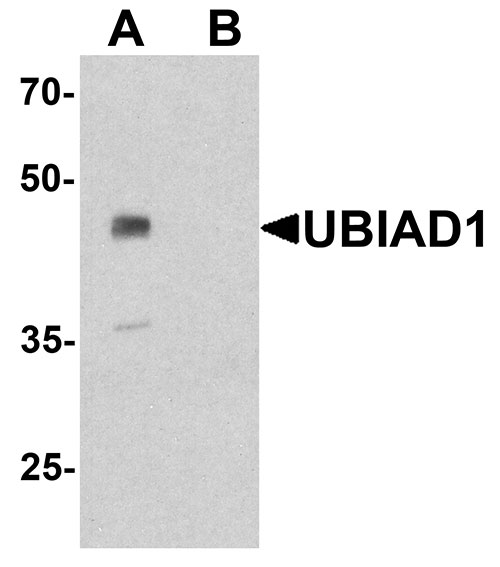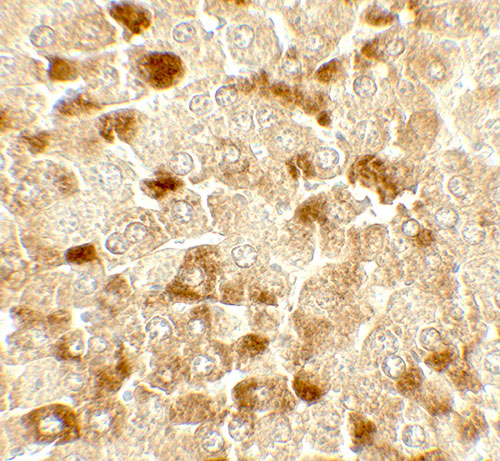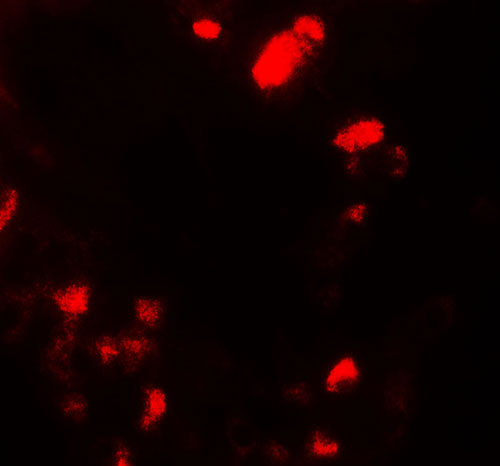UBIAD1 Antibody
- SPECIFICATION
- CITATIONS
- PROTOCOLS
- BACKGROUND

Application
| WB, IHC-P, IF, E |
|---|---|
| Primary Accession | Q9Y5Z9 |
| Other Accession | NP_037451, 7019551 |
| Reactivity | Human, Mouse, Rat |
| Host | Rabbit |
| Clonality | Polyclonal |
| Isotype | IgG |
| Calculated MW | Predicted: 37 kDa Observed: 45 kDa |
| Application Notes | UBIAD1 antibody can be used for detection of UBIAD1 by Western blot at 1 - 2 µg/ml. Antibody can also be used for Immunohistochemistry at 5 µg/mL. For Immunoflorescence start at 20 µg/mL. |
| Gene ID | 29914 |
|---|---|
| Target/Specificity | UBIAD1; UBIAD1 antibody is human, mouse and rat reactive. |
| Reconstitution & Storage | UBIAD1 antibody can be stored at 4℃ for three months and -20℃, stable for up to one year. |
| Precautions | UBIAD1 Antibody is for research use only and not for use in diagnostic or therapeutic procedures. |
| Name | UBIAD1 {ECO:0000303|PubMed:20953171, ECO:0000312|HGNC:HGNC:30791} |
|---|---|
| Function | Prenyltransferase that mediates the formation of menaquinone- 4 (MK-4) and coenzyme Q10 (PubMed:20953171, PubMed:23374346). MK-4 is a vitamin K2 isoform present at high concentrations in the brain, kidney and pancreas, and is required for endothelial cell development (PubMed:20953171). Mediates the conversion of phylloquinone (PK) into MK-4, probably by cleaving the side chain of phylloquinone (PK) to release 2-methyl-1,4-naphthoquinone (menadione; K3) and then prenylating it with geranylgeranyl pyrophosphate (GGPP) to form MK-4 (PubMed:20953171). Also plays a role in cardiovascular development independently of MK-4 biosynthesis, by acting as a coenzyme Q10 biosynthetic enzyme: coenzyme Q10, also named ubiquinone, plays an important antioxidant role in the cardiovascular system (PubMed:23374346). Mediates biosynthesis of coenzyme Q10 in the Golgi membrane, leading to protect cardiovascular tissues from NOS3/eNOS- dependent oxidative stress (PubMed:23374346). |
| Cellular Location | Endoplasmic reticulum membrane; Multi-pass membrane protein. Golgi apparatus membrane; Multi-pass membrane protein. Mitochondrion membrane; Multi-pass membrane protein. Cytoplasm. Nucleus |
| Tissue Location | Ubiquitously expressed. |

Thousands of laboratories across the world have published research that depended on the performance of antibodies from Abcepta to advance their research. Check out links to articles that cite our products in major peer-reviewed journals, organized by research category.
info@abcepta.com, and receive a free "I Love Antibodies" mug.
Provided below are standard protocols that you may find useful for product applications.
Background
The UbiA prenyltransferase domain containing 1 (UBIAD1) protein , also known as TERE1, was initially identified as a down-regulated gene in transitional cell carcinoma of the bladder (1). Recently it has been shown to bind the cholesterol carrier APOE and modulate cellular cholesterol levels (2). Mutations in the UBIAD1 gene can cause Schnyder crystalline corneal dystrophy, an autosomal dominant disease characterized by progressive opacification of the cornea resulting from the local accumulation of lipids (3).
References
McGarvey TW, Nguyen T, Tomaszewski JE, et al. Isolation and characterization of TERE1 gene, a gene down-regulated in transitional cell carcinoma of the bladder. Oncogene 2001; 20:1042-51.
Fredericks WJ, McGarvey T, Wang H, et al. The bladder tumor suppressor protein TERE1 (UBIAD1) modulates cell cholesterol: implications for tumor progression. DNA Cell Biol. 2011; 30:851-64.
Orr A, Dube MP, Marcadier J, et al. Mutations in the UBIAD1 gene, encoding a potential prenyltransferase, are causal for Schnyder crystalline corneal dystrophy. PLoS One 2007; 2:e685.
If you have used an Abcepta product and would like to share how it has performed, please click on the "Submit Review" button and provide the requested information. Our staff will examine and post your review and contact you if needed.
If you have any additional inquiries please email technical services at tech@abcepta.com.













 Foundational characteristics of cancer include proliferation, angiogenesis, migration, evasion of apoptosis, and cellular immortality. Find key markers for these cellular processes and antibodies to detect them.
Foundational characteristics of cancer include proliferation, angiogenesis, migration, evasion of apoptosis, and cellular immortality. Find key markers for these cellular processes and antibodies to detect them. The SUMOplot™ Analysis Program predicts and scores sumoylation sites in your protein. SUMOylation is a post-translational modification involved in various cellular processes, such as nuclear-cytosolic transport, transcriptional regulation, apoptosis, protein stability, response to stress, and progression through the cell cycle.
The SUMOplot™ Analysis Program predicts and scores sumoylation sites in your protein. SUMOylation is a post-translational modification involved in various cellular processes, such as nuclear-cytosolic transport, transcriptional regulation, apoptosis, protein stability, response to stress, and progression through the cell cycle. The Autophagy Receptor Motif Plotter predicts and scores autophagy receptor binding sites in your protein. Identifying proteins connected to this pathway is critical to understanding the role of autophagy in physiological as well as pathological processes such as development, differentiation, neurodegenerative diseases, stress, infection, and cancer.
The Autophagy Receptor Motif Plotter predicts and scores autophagy receptor binding sites in your protein. Identifying proteins connected to this pathway is critical to understanding the role of autophagy in physiological as well as pathological processes such as development, differentiation, neurodegenerative diseases, stress, infection, and cancer.




